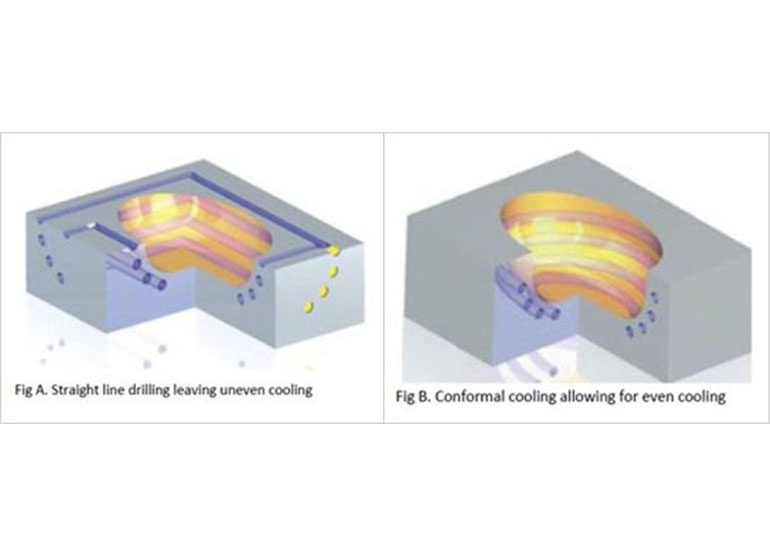
Blogs

Evaluating the efficiency of injection moulding is dependent on its productivity and quality of component. The proximity of cooling channels decides the cooling efficiency. Even a slight variation in the distance between two cooling channels can cause uneven heat dissipation. This result in increased cycle time, sink marks, part warping, reduced tool life due to heat stress and internal part stresses.
Importance of Reduced Cycle Time
The pace of the injection moulding machine in your factory will decide how much profit your company will make. Cooling takes a significant portion of cycle time, which is why it also has major focus when trying to improve business operations.
Conformal cooling tooling has proven effective in reducing cycle time, by as much as 70% in some cases. Till a few years ago, conventional manufacturing techniques could create cooling channels but this usually limited freedom of design and upped the cost of manufacturing in many applications. However, using additive manufacturing (AM), or 3D printing, as it is popularly known, helps you to experiment with fewer limitations, and reduces cycle time effectively.
Using DMLS, it is possible to design and develop extremely complicated geometric shapes and complex functional components in the most cost-effective manner. In essence, direct metal laser sintering lets you insert cooling channels without drilling, thus making the design more feasible and functional.
Points to Consider when using Conformal Cooling Technique
There are four main principles that guide the functioning of conformal cooling method.
1 – Wall Thickness
Cooling time exponentially increases with increase in thickness of walls of the component being manufactured using DMLS conformal cooling method. For instance, a component with a 1-mm thick wall takes around 5 seconds to cool down while a component with walls 5-mm thick may take as much as 40 to 75 seconds.
2 – Thermal diffusion
Thermal diffusion is the ratio of thermal conductivity to heat capacity. This factor is vital because when thermal diffusion of a material is low, the longer it takes to dissipate heat.
3 – Mould temperature
High mould temperatures allow lowering of pressure during the filling phase. This helps to get a better surface finish on components and can also increase cooling time multi-fold.
4 – Pitch and Depth
The depth, size and spacing of cooling channels should cause the temperature to change across the mould surface by 5 to 10 degree Celsius. Increasing the number of cooling channels placed close together near the surface accelerates cooling and also maintains temperature uniformity.
Benefits of Conformal Cooling in Reducing Cycle Time
Conventional cooling methods often cause shrinkage on core side, creates gaps in the part with limited space and the channels in the core are likely to experience higher temperature exchange.
To remedy this, the best way is to use two thermal controllers, choosing a lower-conducting material for cavity and changing the distances between channels and cavity. This method works incredible well for numerous applications.
Here are the distinct benefits of using conformal cooling tooling for prototyping and manufacturing:
1 – Less cycle time
Various studies have shown that conformal cooling can cut cycle time by as much as 70% as compared to traditional cooling channels.
2 – Freedom of design
This technique helps designers to create smooth transitions and smaller diameter channels with elliptical or circular cross-sections. Conformal cooling helps to reach spaces not allowed with conventional cooling channels.
3 – Better quality
With uniform temperature distribution through conformal cooling, it is possible to reduce risk of stress that can cause visual defects and deformation of design. This helps improve product quality noticeably.
Conclusion
Using conformal cooling technique, it is possible to not only reduce cycle time, but also improve product quality, create incredibly complex designs and control the functionality of components more effectively. Last, but not the least, conformal cooling eventually helps to improve your company’s profits.